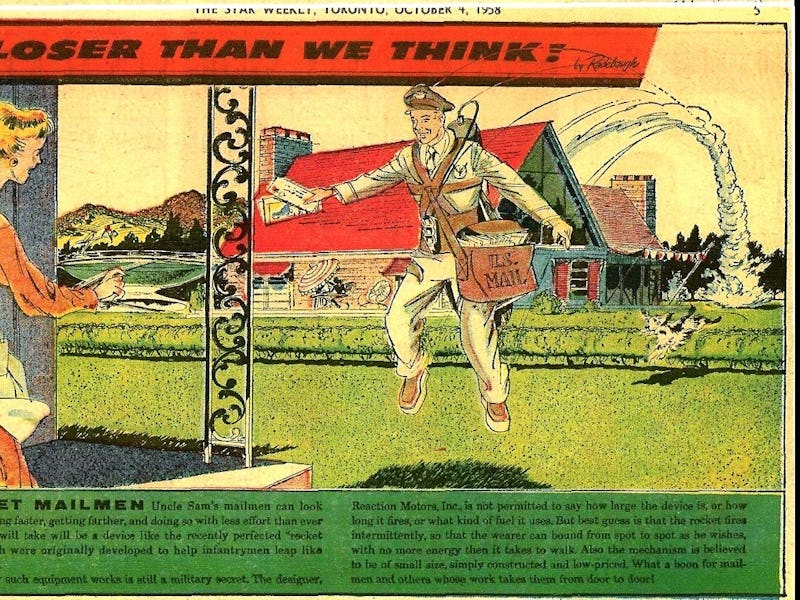A Look Back at the 1950s' Greatest Futurist Illustrator
Arthur Radebaugh's 'Closer Than We Think' syndicated comic was Nuclear Age futurism at its finest.

Debuting in 1958, Arthur Radebaugh’s Closer Than We Think comic brought the newest in technology and futurism to newspapers across the U.S. and Canada. During its four-year span, the illustrations predicting the future of technology were as prescient as they were fantastic. That isn’t to say Radebaugh got it right all of the time. It would be fair to say ideas like “Cities Encased in Glass” and “Space Farming” that maybe fell a bit short of the mark … or maybe they are simply still a few decades ahead of their time.
One of the things that separated his work from his contemporaries was Radebaugh’s dedication to stay abreast of the cutting edge technology of his day. Traveling across North America in a Ford van he converted into a traveling studio, Radebaugh didn’t just want to hear about cutting-edge tech, he wanted to see it, hear it, and feel it. He wanted to talk face-to-face with the inventors and engineers, and then envision what the technology, however theoretical, would look like in practice, but what it could potentially evolve into.
Radebaugh touring the country in his tricked out 1959 Ford Thames van.
It’s a fairly radical conceit, if you think about it: Imagine as one of the leading futurists of today a syndicated cartoonist who seeks the future via land voyages through the wilds of America. But you know what? In that strange postwar era, when Detroit was a tech capital and the South still suffered from tropical diseases, perhaps it made sense to glimpse the future from highway-level. Here are some of the ways Radebaugh totally called the 21st century as we know it.
Video Phones
The Visaphone.
Including some sort of video phone device was pretty common in Nuclear Age depictions of the future, but Radebaugh was able to give a fairly detailed explanation of his how his “Visaphone” would work. Part of that was Radebaugh actually traveling to Bell Telephone Labs and talking to engineers about the tech they were working on at the time.
Surgery with Gamma Knives and Proton Beams
70 years later, bloodless lasers, proton therapy, and the gamma knife are commonly used in medical procedures.
Aside from some of the aesthetics, Radebaugh illustration is not too terribly far off from many medical procedures taking place today. Proton beam therapy has been around in theory since the 1940s, but became a more common tool in the removal of tumors in the 1990s. The “gamma knife” isn’t a knife at all, but rather a method of surgery using ionizing radiation. Add in lasers and endoscopes, and Radebaugh’s vision of bloodless surgeries was pretty accurate.
Water Desalination Plants
Nothing like a little jet-skiing outside the water treatment plant.
Probably not the best venue for water-skiing, but large scale water desalination plants are indeed a thing of the present. While the desalination plants have been used on arid coastal regions like Israel and Saudi Arabia, over the past decade, the state of California plans to build 15 massive plants including the first in San Diego, which will be the largest in the world once operational.
Mechanized Sports Stadiums
It's not quite the new Cowboys Stadium, but check out the retractable glass roof.
As pro-sports stadiums get more and more high-tech, they look more and more like Radebaugh’s illustration. While the self-propelled sectional grandstands are not quite a thing yet, the use of high-tensile building materials, easy conversion between sports, modular grandstands, and even retractable roofing are among the innovations Radebaugh called out back in 1960.
Factory Farms
The blending of science, big industry, and farming.
Monorail tank cars notwithstanding, Radebaugh’s vision of massive consolidated farms that combine cutting-edge science, engineering, and industry are common place in the 2010s. And check out those GMO tomatoes!
Solar Houses
Turntable decks never caught on, but solar power certainly has.
“It’s too bad homes built on turntables never caught on!” said no insurance company ever. But 360-degree rotation aside, Radebaugh did get it right with his prediction that solar energy would become a go-to method for powering and heating houses.
Electromagnetic Paint Jobs
Though not common, color-changing electromagnetic paint jobs exist.
As it turns out, the most farfetched thing about this image is the $1.50 price tag. Electromagnetic color-changing paint may not be available at the detail shop around the corner yet, but the technology definitely does exist. Though ridiculously expensive, you can go out today and get a paint job that will change color depending on the electrical charge applied.